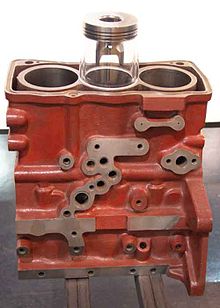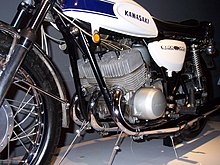Straight-three engine

A straight-three engine (also called an inline-triple or inline-three)[1][2][3] is a three-cylinder piston engine where cylinders are arranged in a line along a common crankshaft.
Less common than straight-four engine, straight-three engines have nonetheless been used in various motorcycles, cars and agricultural machinery.
Design
[edit]
A crankshaft angle of 120 degrees is typically used by straight-three engines,[4] since this results in an evenly spaced firing interval. Another benefit of this configuration is perfect primary balance and secondary balance, however an end-to-end rocking couple is induced because there is no symmetry in the piston velocities about the middle piston. A balance shaft is sometimes used to reduce the vibrations caused by the rocking couple.
Other crankshaft angles have been used occasionally. The 1976–1981 Laverda Jota motorcycle used a 180 degree crankshaft, where the outer pistons rise and fall together and inner cylinder is offset from them by 180 degrees. This results in three power strokes evenly-spaced at 180 degrees each, and then no power strokes during the final 180 degrees of crankshaft rotation. The 2020 Triumph Tiger 900 motorcycle uses a "T-Plane" crankshaft where the crankshaft throws are at 90 intervals, such that the throws for cylinders 1 and 3 are separated by 180 degrees (therefore the three throws together forming a "T" shape when viewed from the end).[5][6]
Usage in cars
[edit]

Among the first cars to use a straight-three engine is the 1953–1955 DKW F91, powered by a 900 cc (55 cu in) two-stroke engine, although this was predated by the 3 cylinder 15hp Rolls Royce produced in 1905 and a number of other cars of this era also used 3 cylinder engines. The 1956–1960 Saab 93 saw the introduction of Saab's 750 cc (46 cu in) two-stroke engine, which was also used in the Saab 95, Saab 96 and Saab Sonett until 1968 after which it was replaced by the Ford Taunus V4 engine.
The Wartburg cars (manufactured in East Germany) and FSO Syrena (manufactured in Poland) also used straight-three engines.
The 1967 Suzuki Fronte 360 uses a 256 cc (16 cu in) two-stroke engine. In 1980, Suzuki began production of a 543 cc (33 cu in) four-stroke engine, which was introduced in the Alto and Fronte models.
The Subaru EF engine is a 4-stroke petrol engine which was introduced in 1984 and used in the Justy[3] and the Sumo (the export version of the Sambar).
The straight-three versions of the Ford EcoBoost engine – a turbocharged 1.0-litre petrol engine – was introduced in the 2012 Ford Focus.[7] It uses an unbalanced flywheel to shift the inherent three-cylinder imbalance to the horizontal plane where it is more easily managed by engine mounts, and so remove the need to use balance shafts.[8] In 2016, cylinder deactivation was added, claimed to be a world first for three-cylinder engines.[9]
| Years | Name | Fuel | Notes |
|---|---|---|---|
| 1977–1993 | Daihatsu C-series | Petrol | Used in the Daihatsu Charade and Daihatsu Mira/Cuore[10] |
| 1983–2001 | Suzuki G10 | Petrol | Debuted in the Suzuki Cultus/Swift[3][11] |
| 1986–1995 | VM Motori R392 | Diesel | Turbocharged, used in the Alfa Romeo 33 |
| 1987–present | Mitsubishi 3G8 | Petrol | Debuted in the Mitsubishi Minica |
| 1991–1992 | Elsbett ELKO 3.82.92t | Diesel | Small-scale production engine for biodiesel conversions |
| 1991–2008 | Daewoo S-TEC | Petrol | Used in the Daewoo Tico and Daewoo Matiz |
| 1996–2002 | GM X10XE | Petrol | Debuted in the Opel Corsa |
| 1998–2007 | Mercedes-Benz M160 | Petrol | Turbocharged, used by Smart |
| 1998–2005 | Volkswagen R3 PD TDI 3L | Diesel | Turbocharged, used in the Volkswagen Lupo and Audi A2[12] |
| 1999–2014 | Mercedes-Benz OM660 | Diesel | Turbocharged, used by Smart |
| 1999–2005 | VM Motori R 315 | Diesel | Turbocharged, debuted in the Hyundai Accent |
| 2000–2006 | Honda ECA1 | Petrol | Used by the Honda Insight hybrid car |
| 2003–present | Mitsubishi 3A9 | Petrol | Debuted in the Mitsubishi Mirage[13] |
| 2004–2011 | Hyundai U engine | Diesel | Turbocharged, debuted in the Kia Picanto |
| 2004–present | Volkswagen R3 (EA111) | Petrol | Debuted in the Volkswagen Fox[14] |
| 2004–2009 | Mercedes-Benz OM639 | Diesel | Turbocharged, used by the Smart Forfour and Mitsubishi Colt[15][16] |
| 2004–present | Toyota 1KR-FE | Petrol | Debuted in the Toyota Aygo |
| 2010–present | Nissan HR | Petrol | Some versions supercharged, debuted in the Nissan Micra[17] |
| 2011–2017 | Fiat XSDE | Diesel | Debuted in the India-market Chevrolet Beat[18] |
| 2012–present | Ford EcoBoost | Petrol | Some versions turbocharged, debuted in the Ford Focus (3rd generation) |
| 2012–present | BMW B37 | Diesel | Turbocharged, debuted in the Mini (F56) |
| 2012–present | Renault TCe | Petrol | Naturally aspirated and Turbocharged, debuted in the Renault Clio IV[broken anchor] |
| 2013–present | BMW B38 | Petrol | Turbocharged, debuted in the BMW i8 |
| 2013–present | GM small gasoline engine | Petrol | Turbocharged, debuted in the Opel Adam[19][20] |
| 2014–present | PSA Group PureTech | Petrol | Naturally aspirated and Turbocharged, debuted in the Peugeot 308 |
| 2018–present | GM E-Turbo | Petrol | Turbocharged; debuted in the Chevrolet Orlando |
| 2020–present | Toyota G16E | Petrol | Turbocharged, debuted in the Toyota GR Yaris |
| 2020-present | Koenigsegg TFG engine | Petrol | Turbocharged, Freevalve engine debuted in Koenigsegg Gemera. |
Usage in motorcycles
[edit]

The advantages of a straight-three engine for motorcycles are that it has a shorter length than an inline-four engine and produces less vibration than a straight-twin engine.[21][page needed]
Four-stroke
[edit]Four-stroke straight-three engines have been used in road bikes and racing bikes by several companies.[22][page needed][23][page needed][24][page needed]
From 1985–1995, the BMW K75 was produced with a straight-three engine (based on the straight-four engine from the BMW K100).
British company Triumph is particularly renowned for a transversely-mounted straight-three engine. Variants have been used in their Speed Triple,[25] Trident, Sprint, and Tiger series. In addition Triumph makes the Rocket III model, various variants of which have held the record for motorcycle with the largest engine displacement.[26]
In 2019, the Moto2 class in the MotoGP World Championship switched to using Triumph 765 cc (46.7 cu in) triple engines.[27]
Two-stroke
[edit]Two-stroke designs are less common in straight-three engines than four-stroke designs, however several were produced by Japanese manufacturers in the late 1960s through to 1980s.
The Kawasaki triple engine was produced from 1968 to 1980 and was used in various road bikes and racing bikes.[28][29] Most versions were air-cooled, however several were water-cooled.[30] Similarly, the 1972–1980 Suzuki GT series engines were used for both road bike and racing bikes, and were available in both air-cooled and water-cooled versions.[30]
Other uses
[edit]Agriculture
[edit]
An example of an agricultural application is the Fairbanks-Morse 32E14 low-speed diesel engine.
The straight-three layout is common for diesel tractor engines, such as the Perkins AD3.152. This engine was used in the Massey Ferguson 35 and Fordson Dextra tractors, as well as for marine and stationary applications.
Aviation
[edit]The Hewland AE75 is a 750 cc two-stroke aircraft engine that was produced in the mid-1980s. It was an inverted three-cylinder design with liquid-cooling that produced 75 bhp (56 kW).[31]
See also
[edit]References
[edit]- ^ Robson, Graham (August 15, 2010). "The car and the team". Saab 96 & V4. Rally Giants. Veloce Publishing. p. 27. ISBN 978-1-84584-256-7.
V4 replaces straight three
- ^ Gorant, Jim (December 1997). Oldham, Joe (ed.). "Jet Ski Saviors". Popular Mechanics. 174 (12). New York, NY USA: Hearst: 54–57. ISSN 0032-4558. Retrieved 2012-07-02.
The 1071cc, inline, triple-cylinder configuration produces 803 pounds of thrust and pushes the boat to about 55 mph.
- ^ a b c Dinkel, John, ed. (July 1988). "Comparison Road Test: 3x3". Road & Track. 39 (11). Newport Beach, CA USA: Diamandis Communications: 66–74. ISSN 0035-7189.
Its engine is still the same 993-cc sohc inline-3, producing 48 bhp at 5100 5100 rpm and 57 lb-ft torque at 3200...
- ^ "Here's The Problem With Three-Cylinder Engines". Car Throttle. Retrieved 2019-12-03.
- ^ "TIGER 900 ENGINE & CAPABILITY". Triumph Motorcycles UK. Retrieved 10 February 2020.
- ^ Cameron, Kevin. "Triumph's New T-Plane Firing Order Explained". Cycleworld. Retrieved 10 February 2020.
- ^ "Smallest Ford Engine Ever! Three-Cylinder EcoBoost (and Two New Transmissions)". Retrieved 2017-04-03.
- ^ "Ford's 3-cyl. EcoBoost Delivers the Goods". 2014-05-15. Retrieved 2017-04-03.
- ^ "Ford To Offer Fuel-Saving Cylinder Deactivation Tech FOR 1.0 Litre EcoBoost; Global First For A 3-Cylinder Engine". 2016-11-29. Retrieved 2017-04-03.
- ^ Logan (September 23, 2011). "New car: 2012 Daihatsu Mira e:S". Motor Mania. Retrieved 2012-07-03.
Motivation comes from a 3-cylinder, 650cc petrol engine that kicks out a mere 51bhp (52PS/38kW) and 60Nm (44lb-ft) of torque.
- ^ Daniel Zevedei. "Suzuki Swift 1.0 GL - 5-doors, hatchback". Auto-types.com. Retrieved 2014-06-20.
- ^ "Audi A2 1.2 TDI: the three-litre car from Audi". AUDI AG - press release (Press release). AudiWorld.com. 1999-11-28. Retrieved 2009-08-22.
- ^ Jackson, Paul (February 1, 2008). "Chapter 6: The Next Generation". The Little Book of Smart. Veloce Publishing. pp. 94–95. ISBN 978-1-84584-148-5.
There were plenty of changes under the skin, too, with the original smart-built turbocharged engine being replaced (on petrol-engined versions) by a Mitsubishi design – still with three cylinders but now a larger (999cc) capacity.
- ^ "New VW Fox in depth". Volkswagen AG. WorldCarFans.com. 2005-04-04. Retrieved 2009-08-18.
- ^ Daniel Zevedei. "Mitsubishi Colt 1.1 Inform - 5-doors, hatchback". Auto-types.com. Retrieved 2014-06-20.
- ^ "Om639 Engine - Diesel Engine - Turbocharger". Scribd. Retrieved 2020-08-24.
- ^ "HR12DDR Engine | NISSAN | TECHNOLOGICAL DEVELOPMENT ACTIVITIES". Nissan-global.com. Retrieved 2014-06-20.
- ^ "LAUNCHED! Chevrolet Beat diesel starts at Rs 4.29 lakh". WWW.bsmotoring.com. BS Motoring. July 25, 2011.
- ^ "New All-Aluminum 3-Cylinder Turbo Sets Refinement Benchmark". Media.opel.com. 2013-08-07. Retrieved 2014-06-20.
- ^ "Opel presents new 1.0 ECOTEC Direct Injection Turbo engine at Aachen Colloquium". Media.gm.com. 2013-10-08. Retrieved 2014-06-20.
- ^ How Your Motorcycle Works: Your Guide to the Components & Systems of Modern Motorcycles. Peter Henshaw Veloce Publishing Ltd, 15 Sep 2012
- ^ 365 Motorcycles You Must Ride. Dain Gingerelli, Charles Everitt, James Manning Michels. MBI Publishing Company, 10 Jan 2011
- ^ The Motorcycle Book, Alan Seeley. MotorBooks International, 2 May 2004
- ^ Human Hurricane, Wilson, Steve. Walneck's Classic Cycle Trader, April 2005
- ^ Cycle world, Volume 44 CBS Publications, 2005. "inline triple"
- ^ Triumph Motorcycles: Twins & Triples. Timothy Remus. MotorBooks International, 10 Oct 1997
- ^ Triumph enters Grand Prix racing as Moto2 engine supplier The Telegraph, 18 December 2018. Retrieved 15 December 2019.
- ^ The Kawasaki Triples Bible: All Road Models 1968–1980, Plus H1r and H2r Racers in Profile. Alastair Walker, Veloce Publishing Ltd, 15 Jan 2011. P.18
- ^ 365 Motorcycles You Must Ride. Dain Gingerelli, Charles Everitt, James Manning Michels. MBI Publishing Company, 10 Jan 2011. P.188
- ^ a b Japanese Production Racing Motorcycles. Mick Walker. Redline Books, Sep 2004
- ^ “Pilot” magazine February 1986 page 32
